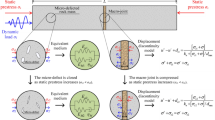Abstract
According to the characteristic of elastic waves propagation in medium and the application of elastic waves method in rock mass engineering, the cranny mass with random crannies was regarded as quasi-isotropic cranny mass. In accordance with the rock rupture mechanics, principle of energy balance and Castiglano’s theorem, the relationship of effective dynamic parameters of elasticity (E, v, G) and cranny density parameters or porosity was put forward. On this basis, through the theory of elastic waves propagation in isotropic medium, the relationship between the elastic wave velocity and cranny density parameters and porosity was set up. The theoretical research results show that, in this kind of cranny rock masses, there is nonlinear relationships between the effective dynamic parameters of elasticity and wave velocities and the cranny density parameter or porosity; and with the increase of cranny density parameter or porosity of cranny rock masses, the effective dynamic modulus and the elastic wave velocities of cranny rock masses will decrease; and at the same time, when the cranny density parameter or porosity is very small, the effective dynamic modulus of elasticity and the elastic wave velocities change with the cranny density parameter, which can explain the sensitivity of effective elastic parameters and elastic wave velocities to cranny rock masses.
Similar content being viewed by others
References
HAN De-hua, Nur A. Effects of porosity and clay constant on wave velocities in sandstones[J]. Geophysics, 1986, 51(11): 2093–2107.
Gaviglio P. Longitudinal waves propagation in a limestone: the relationships between velocities and density [J]. Rock Mech Rock Eng, 1989, 22(4): 290–299.
LI Ji-han. The effect of temperature on the elastic waves and sound emission[J]. Journal of Earthquake, 1986, 8(3): 242–245. (in Chinese)
SHI Ge, SHEN Wen-lue, YANG Dong-quan. The relationship of wave velocities with saturation and fluid distribution in pore space[J]. Chinese Journal of Geophysics, 2003, 46(1): 138–142. (in Chinese)
LIU Zhu-**, WU **&author=Wu%2C**ao-wei&author=Chu%2CZhe-han"> Google Scholar
SHOU Pei. The application of earthquake in engineering[M]. Bei**g: Geology Press, 1982. (in Chinese)
GAO Long-sheng. The research of the elastic wave velocity under high-pressure of rocks from China mainland[J]. Journal of Earth Physics, 1975, 8(1): 26–38. (in Chinese)
WU Shao-wu. Apply the sonic to the stress of adjacent rock[J]. Earthquake, 1984, 4(6): 12–19. (in Chinese)
LUO **-tang. The effect of rock temperature on pressure wave velocity[J]. Journal of Rock and Soil Engineering, 1985, 7(5): 80–84. (in Chinese)
Zimmerman R W, King M S. Propagation of acoustic waves through cranny rock[C]// Ashworth E. Research and Engineering Applications in Rock Masses. Netherlands: A. A. Balkema, 1985: 739–745.
Willis J R. A polarization approach to the scattering of elastic waves: I. scattering by a single inclusion[J]. J Mech Phys Solids, 1980, 28: 287–305.
SHEN Lian-di, SHI Ge. The effect in rock elastic wave velocity by saturability, frequency, type of fluid[J]. Journal of Earth Physics, 1992, 35(Suppl): 322–331. (in Chinese)
Irwin G R. Analysis of stresses and strains near the ends of a cranny traversing a plate[J]. J Appl Mech, 1975, 24: 261–364.
Sih G C. Handbook of stress intensity factors[M]. Bethlehem: Lehigh University, 1973.
Hudson J A. Overall elastic properties of isotripic materials with arbitrary distribution of circular crannies[J]. Geophys J Int, 1990, 102: 465–469.
WANG Hong-tu, XIAN Xue-fu. The propagation characteristic of elastic waves in complicated stress situation[J]. Journal of Chongqing University, 1989, 12(4): 204–207. (in Chinese)
Author information
Authors and Affiliations
Corresponding author
Additional information
Foundation item: Projects(50334060; 50474025) supported by the National Natural Science Foundation of China; project(2005CB221502) supported by the National Key Fundamental Research and Development Program of China
Rights and permissions
About this article
Cite this article
Wang, Ht., Jia, Jq., Li, Xh. et al. Cranny density parameters and porosity measured by elastic wave method in quasi-isotropic cranny rock masses. J Cent. South Univ. Technol. 13, 598–602 (2006). https://doi.org/10.1007/s11771-006-0095-4
Received:
Accepted:
Published:
Issue Date:
DOI: https://doi.org/10.1007/s11771-006-0095-4
Key words
- quasi-isotropic cranny mass
- wave velocities
- effective dynamic parameter
- cranny density parameter
- porosity




